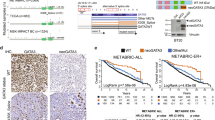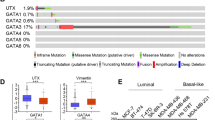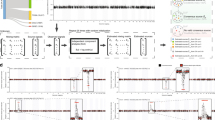Abstract
Lineage-restricted transcription factors (TFs) are frequently mutated or overexpressed in cancer and contribute toward malignant behaviors; however, the molecular bases of their oncogenic properties are largely unknown. As TF activities are difficult to inhibit directly with small molecules, the genes and pathways they regulate might represent more tractable targets for drug therapy. We studied GATA6, a TF gene that is frequently amplified or overexpressed in gastric, esophageal and pancreatic adenocarcinomas. GATA6-overexpressing gastric cancer cell lines cluster in gene expression space, separate from non-overexpressing lines. This expression clustering signifies a shared pathogenic group of genes that GATA6 may regulate through direct cis-element binding. We used chromatin immunoprecipitation and sequencing (ChIP-seq) to identify GATA6-bound genes and considered TF occupancy in relation to genes that respond to GATA6 depletion in cell lines and track with GATA6 mRNA (synexpression groups) in primary gastric cancers. Among other cellular functions, GATA6-occupied genes control apoptosis and govern the M-phase of the cell cycle. Depletion of GATA6 reduced the levels of the latter transcripts and arrested cells in G2 and M phases of the cell cycle. Synexpression in human tumor samples identified likely direct transcriptional targets substantially better than consideration only of transcripts that respond to GATA6 loss in cultured cells. Candidate target genes responded to the loss of GATA6 or its homolog GATA4 and even more to the depletion of both proteins. Many GATA6-dependent genes lacked nearby binding sites but several strongly dependent, synexpressed and GATA6-bound genes encode TFs such as MYC, HES1, RARB and CDX2. Thus, many downstream effects occur indirectly through other TFs and GATA6 activity in gastric cancer is partially redundant with GATA4. This integrative analysis of locus occupancy, gene dependency and synexpression provides a functional signature of GATA6-overexpressing gastric cancers, revealing both limits and new therapeutic directions for a challenging and frequently fatal disease.
This is a preview of subscription content, access via your institution
Access options
Subscribe to this journal
Receive 50 print issues and online access
$259.00 per year
only $5.18 per issue
Buy this article
- Purchase on Springer Link
- Instant access to full article PDF
Prices may be subject to local taxes which are calculated during checkout








Similar content being viewed by others
References
Garraway LA, Widlund HR, Rubin MA, Getz G, Berger AJ, Ramaswamy S et al. Integrative genomic analyses identify MITF as a lineage survival oncogene amplified in malignant melanoma. Nature 2005; 436: 117–122.
Weir BA, Woo MS, Getz G, Perner S, Ding L, Beroukhim R et al. Characterizing the cancer genome in lung adenocarcinoma. Nature 2007; 450: 893–898.
Bass AJ, Watanabe H, Mermel CH, Yu S, Perner S, Verhaak RG et al. SOX2 is an amplified lineage-survival oncogene in lung and esophageal squamous cell carcinomas. Nat Genet 2009; 41: 1238–1242.
Visakorpi T, Hyytinen E, Koivisto P, Tanner M, Keinanen R, Palmberg C et al. In vivo amplification of the androgen receptor gene and progression of human prostate cancer. Nat Genet 1995; 9: 401–406.
Darnell JE Jr. . Transcription factors as targets for cancer therapy. Nat Rev Cancer 2002; 2: 740–749.
Redell MS, Tweardy DJ . Targeting transcription factors for cancer therapy. Curr Pharm Des 2005; 11: 2873–2887.
Dulak AM, Schumacher S, van Lieshout J, Imamura Y, Fox C, Shim B et al. Gastrointestinal adenocarcinomas of the esophagus, stomach and colon exhibit distinct patterns of genome instability and oncogenesis. Cancer Res 2012; 72: 4383–4393.
Alvarez H, Opalinska J, Zhou L, Sohal D, Fazzari MJ, Yu Y et al. Widespread hypomethylation occurs early and synergizes with gene amplification during esophageal carcinogenesis. PLoS Genet 2011; 7: e1001356.
Lin L, Bass AJ, Lockwood WW, Wang Z, Silvers AL, Thomas DG et al. Activation of GATA binding protein 6 (GATA6) sustains oncogenic lineage-survival in esophageal adenocarcinoma. Proc Natl Acad Sci USA 2012; 109: 4251–4256.
Ferlay J, Shin HR, Bray F, Forman D, Mathers C, Parkin DM . Estimates of worldwide burden of cancer in 2008: GLOBOCAN 2008. Int J Cancer 2010; 127: 2893–2917.
Matsuda A, Machii R . Trends in stomach cancer mortality rates in Japan, USA, UK, France and Korea based on the WHO mortality database. Jpn J Clin Oncol 2012; 42: 154.
Nakajima M, Sawada H, Yamada Y, Watanabe A, Tatsumi M, Yamashita J et al. The prognostic significance of amplification and overexpression of c-met and c-erb B-2 in human gastric carcinomas. Cancer 1999; 85: 1894–1902.
Lennerz JK, Kwak EL, Ackerman A, Michael M, Fox SB, Bergethon K et al. MET amplification identifies a small and aggressive subgroup of esophagogastric adenocarcinoma with evidence of responsiveness to crizotinib. J Clin Oncol 2011; 29: 4803–4810.
Okines A, Cunningham D, Chau I . Targeting the human EGFR family in esophagogastric cancer. Nat Rev Clin Oncol 2011; 8: 492–503.
Laverriere AC, MacNeill C, Mueller C, Poelmann RE, Burch JB, Evans T . GATA-4/5/6, a subfamily of three transcription factors transcribed in developing heart and gut. J Biol Chem 1994; 269: 23177–23184.
Fang R, Olds LC, Sibley E . Spatio-temporal patterns of intestine-specific transcription factor expression during postnatal mouse gut development. Gene Expr Patterns 2006; 6: 426–432.
Beuling E, Baffour-Awuah NY, Stapleton KA, Aronson BE, Noah TK, Shroyer NF et al. GATA factors regulate proliferation, differentiation, and gene expression in small intestine of mature mice. Gastroenterology 2011; 140: 1219–1229.
Verzi MP, Shin H, He HH, Sulahian R, Meyer CA, Montgomery RK et al. Differentiation-specific histone modifications reveal dynamic chromatin interactions and partners for the intestinal transcription factor CDX2. Dev Cell 2010; 19: 713–726.
Schmidt PH, Lee JR, Joshi V, Playford RJ, Poulsom R, Wright NA et al. Identification of a metaplastic cell lineage associated with human gastric adenocarcinoma. Lab Invest 1999; 79: 639–646.
Fu B, Luo M, Lakkur S, Lucito R, Iacobuzio-Donahue CA . Frequent genomic copy number gain and overexpression of GATA-6 in pancreatic carcinoma. Cancer Biol Ther 2008; 7: 1593–1601.
Kwei KA, Bashyam MD, Kao J, Ratheesh R, Reddy EC, Kim YH et al. Genomic profiling identifies GATA6 as a candidate oncogene amplified in pancreatobiliary cancer. PLoS Genet 2008; 4: e1000081.
Beroukhim R, Getz G, Nghiemphu L, Barretina J, Hsueh T, Linhart D et al. Assessing the significance of chromosomal aberrations in cancer: methodology and application to glioma. Proc Natl Acad Sci USA 2007; 104: 20007–20012.
Holtzinger A, Evans T . Gata4 regulates the formation of multiple organs. Development 2005; 132: 4005–4014.
Zhao R, Watt AJ, Battle MA, Li J, Bondow BJ, Duncan SA . Loss of both GATA4 and GATA6 blocks cardiac myocyte differentiation and results in acardia in mice. Dev Biol 2008; 317: 614–619.
Cheung HW, Cowley GS, Weir BA, Boehm JS, Rusin S, Scott JA et al. Systematic investigation of genetic vulnerabilities across cancer cell lines reveals lineage-specific dependencies in ovarian cancer. Proc Natl Acad Sci USA 2011; 108: 12372–12377.
Welch JJ, Watts JA, Vakoc CR, Yao Y, Wang H, Hardison RC et al. Global regulation of erythroid gene expression by transcription factor GATA-1. Blood 2004; 104: 3136–3147.
Yu M, Riva L, Xie H, Schindler Y, Moran TB, Cheng Y et al. Insights into GATA-1-mediated gene activation versus repression via genome-wide chromatin occupancy analysis. Mol Cell 2009; 36: 682–695.
Jang JH, Shin KH, Park JG . Mutations in fibroblast growth factor receptor 2 and fibroblast growth factor receptor 3 genes associated with human gastric and colorectal cancers. Cancer Res 2001; 61: 3541–3543.
Kunii K, Davis L, Gorenstein J, Hatch H, Yashiro M, Di Bacco A et al. FGFR2-amplified gastric cancer cell lines require FGFR2 and Erbb3 signaling for growth and survival. Cancer Res 2008; 68: 2340–2348.
Abdi H, Williams LJ . Principal component analysis. CompStat 2010; 2: 433–459.
Zeitlinger J, Zinzen RP, Stark A, Kellis M, Zhang H, Young RA et al. Whole-genome ChIP-chip analysis of Dorsal, Twist, and Snail suggests integration of diverse patterning processes in the Drosophila embryo. Genes Dev 2007; 21: 385–390.
Eeckhoute J, Lupien M, Meyer CA, Verzi MP, Shivdasani RA, Liu XS et al. Cell-type selective chromatin remodeling defines the active subset of FOXA1-bound enhancers. Genome Res 2009; 19: 372–380.
Tamura S, Wang XH, Maeda M, Futai M . Gastric DNA-binding proteins recognize upstream sequence motifs of parietal cell-specific genes. Proc Natl Acad Sci USA 1994; 91: 4609 1993;90:10876-80.
Gao X, Sedgwick T, Shi YB, Evans T . Distinct functions are implicated for the GATA-4, -5, and -6 transcription factors in the regulation of intestine epithelial cell differentiation. Mol Cell Biol 1998; 18: 2901–2911.
Beck F, Chawengsaksophak K, Waring P, Playford RJ, Furness JB . Reprogramming of intestinal differentiation and intercalary regeneration in Cdx2 mutant mice. Proc Natl Acad Sci USA 1999; 96: 7318–7323.
Verzi MP, Shin H, Ho LL, Liu XS, Shivdasani RA . Essential and redundant functions of caudal family proteins in activating adult intestinal genes. Mol Cell Biol 2011; 31: 2026–2039.
Chen X, Leung SY, Yuen ST, Chu KM, Ji J, Li R et al. Variation in gene expression patterns in human gastric cancers. Mol Biol Cell 2003; 14: 3208–3215.
Barker N, van Es JH, Kuipers J, Kujala P, van den Born M, Cozijnsen M et al. Identification of stem cells in small intestine and colon by marker gene Lgr5. Nature 2007; 449: 1003–1007.
Barker N, Huch M, Kujala P, van de Wetering M, Snippert HJ, van Es JH et al. Lgr5(+ve) stem cells drive self-renewal in the stomach and build long-lived gastric units in vitro. Cell Stem Cell 2010; 6: 25–36.
Heng JC, Feng B, Han J, Jiang J, Kraus P, Ng JH et al. The nuclear receptor Nr5a2 can replace Oct4 in the reprogramming of murine somatic cells to pluripotent cells. Cell Stem Cell 2010; 6: 167–174.
Kageyama R, Ohtsuka T, Kobayashi T . The Hes gene family: repressors and oscillators that orchestrate embryogenesis. Development 2007; 134: 1243–1251.
Kim TH, Shivdasani RA . Notch signaling in stomach epithelial stem cell homeostasis. J Exp Med 2011; 208: 677–688.
Ross J, Mavoungou L, Bresnick EH, Milot E . GATA-1 utilizes Ikaros and polycomb repressive complex 2 to suppress Hes1 and to promote erythropoiesis. Mol Cell Biol 2012; 32: 3624–3638.
Guiu J, Shimizu R, D'Altri T, Fraser ST, Hatakeyama J, Bresnick EH et al. Hes repressors are essential regulators of hematopoietic stem cell development downstream of Notch signaling. J Exp Med 2013; 210: 71–84.
Irizarry RA, Hobbs B, Collin F, Beazer-Barclay YD, Antonellis KJ, Scherf U et al. Exploration, normalization, and summaries of high density oligonucleotide array probe level data. Biostat 2003; 4: 249–264.
Shechter D, Dormann HL, Allis CD, Hake SB . Extraction, purification and analysis of histones. Nat Protoc 2007; 2: 1445–1457.
Liu T, Ortiz JA, Taing L, Meyer CA, Lee B, Zhang Y et al. Cistrome: an integrative platform for transcriptional regulation studies. Genome Biol 2011; 12: R83.
Robinson JT, Thorvaldsdottir H, Winckler W, Guttman M, Lander ES, Getz G et al. Integrative genomics viewer. Nat Biotechnol. 2011; 29: 24–26.
Acknowledgements
This study was supported by the Dana-Farber Cancer Institute-Novartis Drug Discovery Program and National Institutes of Health awards R01CA151993 (SO), R01HG4069 (XSL), K08CA134931 (AJB) and the SPORE program in GI cancers P50 CA127003. Data associated with this study are available in the GEO, GSE51936.
Author information
Authors and Affiliations
Corresponding author
Ethics declarations
Competing interests
The authors declare no conflict of interest.
Additional information
Supplementary Information accompanies this paper on the Oncogene website
Rights and permissions
About this article
Cite this article
Sulahian, R., Casey, F., Shen, J. et al. An integrative analysis reveals functional targets of GATA6 transcriptional regulation in gastric cancer. Oncogene 33, 5637–5648 (2014). https://doi.org/10.1038/onc.2013.517
Received:
Revised:
Accepted:
Published:
Issue Date:
DOI: https://doi.org/10.1038/onc.2013.517
Keywords
This article is cited by
-
The dynamic alteration of transcriptional regulation by crucial TFs during tumorigenesis of gastric cancer
Molecular Medicine (2022)
-
Detection and identification of cis-regulatory elements using change-point and classification algorithms
BMC Genomics (2022)
-
Early Gastric Cancer: identification of molecular markers able to distinguish submucosa-penetrating lesions with different prognosis
Gastric Cancer (2021)
-
Fibroblast GATA-4 and GATA-6 promote myocardial adaptation to pressure overload by enhancing cardiac angiogenesis
Basic Research in Cardiology (2021)
-
Reprogramming of the esophageal squamous carcinoma epigenome by SOX2 promotes ADAR1 dependence
Nature Genetics (2021)



